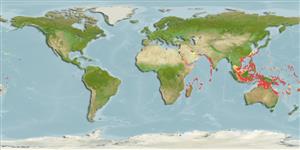>
Gobiiformes (Gobies) >
Gobiidae (Gobies) > Gobiinae
Etymology: Paragobiodon: Greek, para = the side of + Latin, gobius = gudgeon + Greek,odous =teeth (Ref. 45335).
More on author: Bleeker.
Environment: milieu / climate zone / depth range / distribution range
Ecologia
marinhas associadas(os) a recifes; intervalo de profundidade ? - 70 m (Ref. 86942). Tropical; 30°N - 32°S, 32°E - 169°W
Indo-Pacific.
Tamanho / Peso / Idade
Maturity: Lm ? range ? - ? cm
Max length : 4.0 cm TL macho/indeterminado; (Ref. 2798)
Descrição suscinta
Chaves de identificação | Morfologia | Morfometria
Espinhos dorsais (total) : 7; Raios dorsais (total) : 8 - 10; Espinhos anais: 1; Raios anais : 8 - 9. Green to greenish yellow in color, often with a dark caudal margin; adults with elongate flaps on top of head (Ref. 1602). Transverse scales 10. Mouth nearly vertical, lips thick. Head and nape naked to first dorsal fin origin. Gill opening located at same level as pectoral base. Ventral small; first dorsal and anal lower than 2nd dorsal; pectoral extends beyond anus; caudal rounded. Scales less firmly attached than other congeneric species (Ref. 43541).; characterized further by having longitudinal scale series 22-24; ctenoid scales except head, nape, prepectoral region, breast and midventral portion of abdomen which is scaleless; head and nape with numerous bristle-like cirri; complete pelvic fin frenum and basal membrane; depth of body at level of pelvic fins 2.6-3.1 in SL (Ref. 90102).
Found exclusively among branches of Seriatopora hystrix coral (Ref. 2334); usually in pairs. Monogamous (Ref. 52884).
Ciclo de vida ou comportamento de acasalamento
Maturities | Reprodução | Spawnings | Egg(s) | Fecundities | Larvas
Monogamous mating is observed as both obligate and social (Ref. 52884).
Randall, J.E., G.R. Allen and R.C. Steene, 1990. Fishes of the Great Barrier Reef and Coral Sea. University of Hawaii Press, Honolulu, Hawaii. 506 p. (Ref. 2334)
Status na Lista Vermelha da UICN (Ref. 130435)
Ameaça para os humanos
Harmless
Uso pelos humanos
Pescarias: espécies comerciais; Aquário: Espécies comerciais
Ferramentas
Relatórios especiais
Baixar XML
Fontes da internet
Estimates based on models
Preferred temperature (Ref.
123201): 25 - 29.3, mean 28.2 °C (based on 1954 cells).
Índice de diversidade filogenética (Ref.
82804): PD
50 = 0.5156 [Uniqueness, from 0.5 = low to 2.0 = high].
Bayesian length-weight: a=0.01995 (0.00906 - 0.04395), b=3.01 (2.83 - 3.19), in cm total length, based on all LWR estimates for this body shape (Ref.
93245).
Nível Trófico (Ref.
69278): 3.1 ±0.3 se; based on size and trophs of closest relatives
Resiliência (Ref.
120179): Elevada, tempo mínimo de duplicação da população menor que 15 meses (Preliminary K or Fecundity.).
Fishing Vulnerability (Ref.
59153): Low vulnerability (10 of 100).
Nutrients (Ref.
124155): Calcium = 242 [98, 530] mg/100g; Iron = 1.21 [0.57, 2.59] mg/100g; Protein = 17.8 [15.7, 19.6] %; Omega3 = 0.138 [0.050, 0.316] g/100g; Selenium = 34.9 [13.8, 79.8] μg/100g; VitaminA = 78.8 [17.4, 363.7] μg/100g; Zinc = 2.64 [1.58, 4.24] mg/100g (wet weight);
